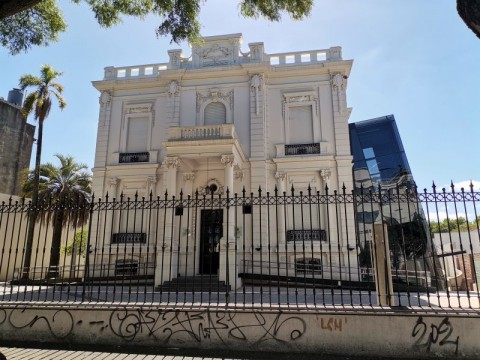Servicio de Información de Defensa (SID)
Summary
Data
Alias
“La Mansión”, “La Casona” o “La casa de Bulevar y Palmar”
Type of place
Location
Country
Address
Bulevar Artigas 1488 (actual 1532)
Institutional responsibility
Servico de Información y Defensa (SID)
Operating period
1976
Current situation
Sitio de Memoria abierto al público y sede de la Institución Nacional de Derechos Humanos
Place ID
SMLG-UYMO-01
Related victims
Ficha de víctima #435 - Gelman Garcia, María Macarena  |
| Ficha de víctima #425 - Nores Montedónico, Alvaro |
Ficha de víctima #388 - Julien Grisonas, Anatole Boris  |
| Ficha de víctima #389 - Julien Grisonas, Victoria Eva |
| Ficha de víctima #360 - García Iruretagoyena Cassinelli de Gelman, María Claudia |
| Ficha de víctima #323 - Zahn Freire, Edelweiss |
| Ficha de víctima #332 - Zina Figueredo, Gastón |
| Ficha de víctima #331 - Petrides, Marta |
| Ficha de víctima #330 - Lubián Peláez, Víctor Hugo |
| Ficha de víctima #329 - Soto Loureiro, Ariel Rogelio |
| Ficha de víctima #328 - Salvo Sánchez, Ana María |
| Ficha de víctima #326 - Rodríguez Larreta Piera, Enrique Carlos |
| Ficha de víctima #325 - Rama Molla, María Elba |
| Ficha de víctima #324 - Nogueira Pauillier, Raquel |
| Ficha de víctima #322 - Cadenas Ravela, Alicia Raquel |
| Ficha de víctima #321 - Díaz Berdayes, José Félix |
| Ficha de víctima #319 - Anzalone Cantoni, Laura Haydeé |
| Ficha de víctima #318 - Quadros Herrera, Ana Inés |
| Ficha de víctima #317 - Michelini Delle Piane, María Margarita |
| Ficha de víctima #315 - Maceiro Perez, Asilú Sonia |
| Ficha de víctima #314 - López Burgos, Sergio Ruben |
| Ficha de víctima #311 - Dean Bermúdez, Eduardo |
| Ficha de víctima #310 - Altuna Facal, Raúl Luis |
| Ficha de víctima #307 - Gayoso Jauregui, Cecilia Irene |
| Ficha de víctima #305 - Soliño Platero, María Mónica |
| Ficha de víctima #300 - Rodríguez Larreta Martínez, Enrique (hijo) |
Ficha de víctima #316 - Méndez Lompodio, Sara Rita  |
| Ficha de víctima #293 - Pérez Lutz, Elizabeth |
| Ficha de víctima #290 - González Cardozo, Jorge Raúl |
| Ficha de víctima #260 - Nores Montedónico, María del Pilar |

